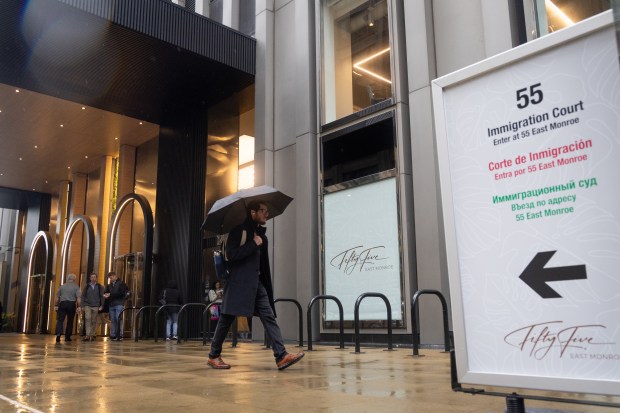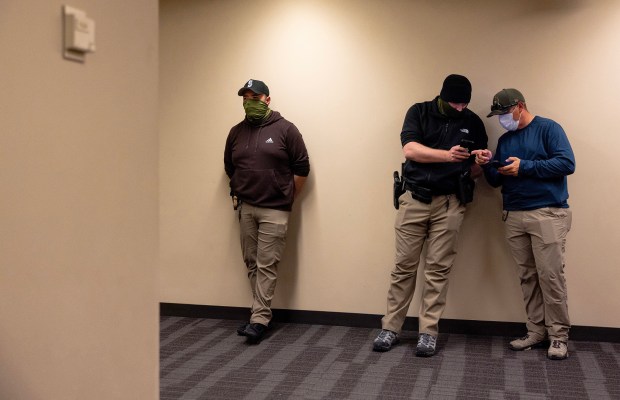Federal agents appeared to have arrested multiple people inside Chicago’s immigration court on Wednesday, lawyers told the Tribune, in what seems to be the latest escalation in President Donald Trump’s bid to enact mass deportations.
Throughout Wednesday, groups of men were spotted detaining individuals inside the downtown courthouse, with many of those agents wearing badges or verbally identifying themselves as U.S. Immigration and Customs Enforcement officers, according to four attorneys.
An ICE spokesperson did not provide immediate comment Wednesday, but a Tribune reporter also witnessed three individuals be taken into custody by men dressed in plainclothes and holding clipboards early Wednesday afternoon. Their lawyer, Essam Abdallah, told the Tribune his clients are immigrants who have been in the country for under two years but did not know where they were being taken.
“I’m not sure what’s going on,” a surprised Abdallah said as he left the courthouse to find a way to help his clients.
News outlets across the U.S. have similarly reported on federal agents detaining individuals during immigration hearings and check-ins in Dallas, Phoenix and Seattle this month. In Chicago, several attorneys who were at the immigration courthouse Wednesday said they noticed men sitting by the waiting area and inside the courtrooms, with one lawyer saying he followed the detainees to the fourth floor where immigration arrests are processed.
Another attorney, Alex McGriff, said he was at the courthouse for most of Wednesday and heard the men identify themselves as ICE agents to the people they approached. McGriff monitored the court hearings as part of the National Immigrant Justice Center to learn more of ICE’s latest move.
The practice of ICE entering the courthouses to detain individuals who are there for deportation or other immigration proceedings is a shift that signals a more aggressive tactic by the Trump administration. It comes as his campaign promise to drastically ramp up deportations has seen a chaotic rollout but has so far fallen short of his goals numbers-wise, with recent reports indicating that removals have lagged behind those that happened during the Biden administration.
While ICE is allowed inside courthouses, advocates worry the presence of agents will have a chilling effect on immigrants due for routine check-ins or hearings. Immigration lawyers said the Trump administration appeared to be coordinating efforts to dismiss cases of individuals in the U.S. for less than two years so that federal agents can immediately detain them, potentially for an expedited removal order.
Trump in January expanded that designation, traditionally only used at the border, to apply to any noncitizen without legal status who cannot prove they’ve been in the country for more than two years. Those individuals are not owed a hearing before an immigration judge.
Aaron Lawee, an immigration attorney with Minsky, McCormick & Hallagan, was in court when he saw government attorneys move to dismiss two separate cases. In both instances, he said, two individuals were waiting outside the courtroom to detain the respondents.
In one case, Lawee said, a woman from Vietnam had an attorney, though the attorney was present via videoconference and not physically in court. The woman was eventually able to talk to her attorney, who informed the agents she had an asylum application and was entitled to an interview.
In the other instance, the man did not have an attorney, Lawee said. The judge allowed the man 10 days to respond to the government’s request to dismiss the matter, he said. He accompanied the man to the ICE office, and learned that he had a criminal conviction, which appeared to be the reason for the detention.
“This tactic of switching someone from a non-detained case to a detained case really stacks the deck against them,” he said. “The deck is already stacked against immigrants. Unlike in criminal court, this is more like you’re guilty until proven innocent.”
Another attorney who asked to remain anonymous to protect their client told the Tribune they were at a downtown immigration court Wednesday and saw the government move to dismiss their client’s case. That government official would only explain, “The circumstances have changed.”
Victoria Carmona, a clinical professor of law at Chicago-Kent College of Law, called the maneuver to dismiss cases to then expedite deportation “unprecedented” and said it appeared to be a coordinated, nationwide effort rolled out in multiple cities.
“It’s definitely to detain as many people as possible,” she said. “It’s easy detention, and absolutely to quickly deport people.”
Attorneys urged people to still attend their court dates because failing to show up would lead to a removal order, but said family members who would come in a supportive role may opt to stay home.
“People are going to be afraid to go to court,” Carmona said.

Many are unaware that there may be legal avenues available to challenge their arrests and the expedited removal process being applied to them, said immigration attorney Khiabett Osuna.
Osuna was there on Wednesday morning with one of her clients when she noticed the apparent agents in the waiting room and inside the courtroom.
“There is a real risk for people who are navigating this process without representation,” said Osuna. “Those without attorneys are not being informed of their rights or potential defenses, leaving them at a heightened risk of immediate detention and removal.”
More than 50,000 asylum seekers, mostly from Venezuela but also from Haiti and other countries suffering instability, have arrived in Chicago since 2022. The U.S. Supreme Court this week sided with the Trump administration’s move to revoke the Temporary Protected Status of 350,000 Venezuelans, but a tangled web of pending litigation over other protections from immigrants targeted by the White House continues unfolding in courts.
Chicago has often been in the crosshairs of White House since Trump’s second term started. Mayor Brandon Johnson, a progressive first-termer, has decried the president as a “tyrant” and went to Washington in March for a congressional hearing in which he defended Chicago’s sanctuary policy that prohibits local law enforcement from cooperating with federal immigration authorities.
However, ICE has been moving ahead with deportations in the nation’s third-largest city even without Chicago police’s help. That was evident during the citywide immigration raids attended by Trump’s border czar Tom Homan and the TV personality Dr. Phil in January — and now in Wednesday’s courthouse arrests.
Rey Wences, senior director of deportation defense at Illinois Coalition for Immigrant and Refugee Rights, called the arrests “deeply troubling.”
“We know that ICE and the Department of Homeland Security are using this strategy to snatch and disappear people in different cities nationwide,” Wences said. “This is a deeply troubling development that instills fear in communities, creates barriers for people going through the immigration process, and only serves to pad Trump’s deportation numbers at the expense of everyday families. Trump and DHS are trying to use a shortcut to deny due process to our family members and neighbors.”



